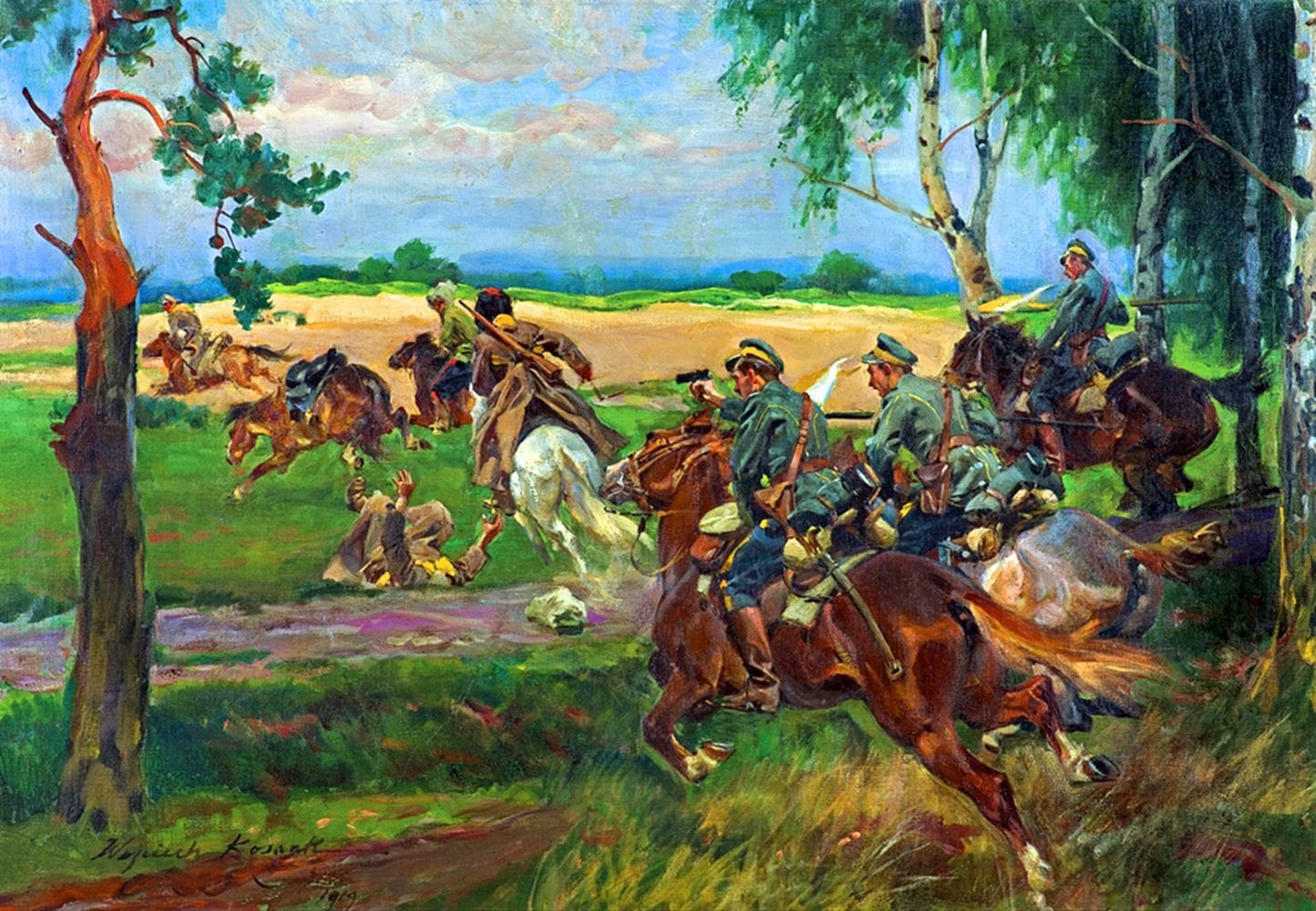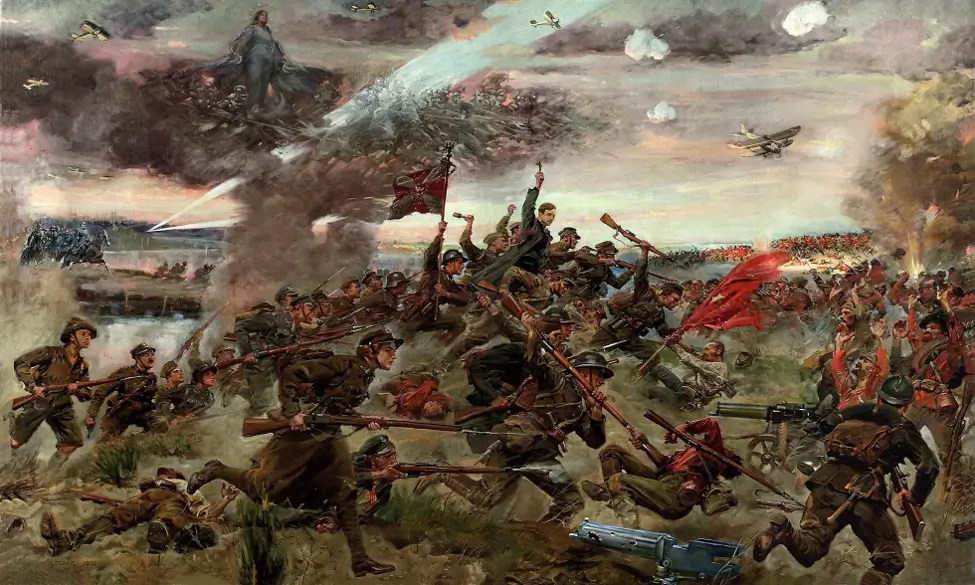
The 1920 Polish Victory that saved Europe from Communism

The British Envoy to Warsaw in 1920, Edgar Vincent D’Abernon, wrote in his 1931 memoir, The Eighteenth Decisive Battle of the World: Warsaw, 1920, that the fight for the Polish capital that summer was one of the most important battles in world history. Yet, the Battle of Warsaw, often called “Miracle on the Vistula”, is, like much of Polish history, almost unknown to English-speaking audiences. The following summary of the Polish-Soviet War and the Battle for Warsaw provides a thought-provoking account of why D’Abernon considers this one of the most important battles in world history.
World War I ended when Germany lost the war and signed the Armistice of 11 November 1918. Because of the Treaty of Versailles, Poland was reborn as a nation state after disappearing from the map in 1795 following its partitioning by Russia, Prussia, and Austro-Hungary. As German troops systematically retreated from Ukraine, Belarus, and the Baltic states, they were immediately followed by the Bolshevik Red Army, fulfilling Lenin’s orders to begin its march westward and “free those oppressed by capitalism”. (Although the Bolsheviks overthrew the Russian Empire, it was not officially renamed the Soviet Union until 1922. For continuity, and to follow most historians’ accounts, the Polish–Soviet War (February 1919 – March 1921) was primarily fought between the Second Polish Republic and the Russian Soviet Federative Socialist Republic on territories that were formerly held by the Russian Empire and the Austro-Hungarian Empire, which were taken from Poland in 1795.)
For Moscow, spreading communism westward in 1920 was not only desired, it was an ideological imperative. The objective was to spread communism to more advanced, industrialized countries, most importantly Germany. This is because Germany in 1920 was in a state of near-collapse; its economy was in ruins, its population was exhausted, angry and disillusioned, and its political life was burdened with revolutionary tensions. If there was ever a time for the Red Army to incite German communists and other malcontents to victory, it was now. It was no surprise therefore that Marshal Mikhail Tukhachevsky’s order of the day to his troops was: “Soldiers of the workers’ revolution, turn your eyes to the west. The fate of world revolution is being decided in the west. Over the corpse of White Poland lies the road to worldwide conflagration. On our bayonets we will carry happiness and peace to working humanity. To the west, to decisive battles, to great victories! Form your ranks, the hour of the offensive to Vilnius, Minsk, and Warsaw has struck. Forward!”
For Poland, his military order had the threatening codename “Vistula”. The most important goal for the Bolsheviks was to break through to Germany and Austria, where revolutionary sentiment prevailed. A week after Germany signed the Armistice, the Red Army’s commander, Leon Trotsky, told his generals that Poland and Ukraine must be Sovietized and serve as “the links binding Soviet Russia with future Soviet Germany,” and the first stage in building “the Union of European Proletariat Republics”. According to the country’s leader, Vladimir Lenin, the occupation of Germany was key to the communist revolution on the entire European continent and then the whole world. Poland was the last obstacle standing between Russian communism and the rest of Europe. The first military clash between the Red Army and Polish units took place in January 1919, which marked the start of a two-year war. What was at stake was not just the issue of Poland’s eastern borders, but also the very existence of an independent Polish state, free from totalitarian enslavement.
Poles at the time imagined a reborn Polish state with borders similar to those the Republic of Poland had before it was partitioned, which included Lithuanian, Belarusian, and Ukrainian lands. The main goal of Poland’s leader, Marshal Józef PiÅ‚sudski, was to rebuild a strong Poland that was capable of surviving between Germany and Russia. To achieve that, it was necessary to weaken Russia as much as possible by depriving it of not only Ukraine, Belarus, and Lithuania, but also Latvia, Estonia, Finland, and the Caucasian countries. In this way, a bloc of “Intermarium” states was to be created.
At the time, the Polish Army was just being formed and had to use most of its forces to fight against the Ukrainians for Lwów and Eastern Galicia. However, PiÅ‚sudski did not intend to idly wait for the Bolsheviks to enter Warsaw. In February 1919, he launched a pre-emptive attack, entering the lands of today’s western Belarus left by the Germans. Despite having relatively small forces and being outnumbered by the Red Army, he displayed notable strategic skills. In April 1919, as a result of a successful offensive, Polish troops seized the region of Vilnius, and in the summer of 1919, most of the Belarusian lands up to the line of the rivers Daugava and Berezina. This “Polish barrier” prevented the Bolsheviks from coming to the aid of the communist republics in Hungary and Bavaria.
Contrary to old communist claims, and today’s Russian propaganda, PiÅ‚sudski was not filled with hatred towards Russia and the Russian people. He simply understood that Russia would always be an imperialistic state and stressed this point in one of his orders, stating that “We are not fighting against the Russian nation, but against the Bolshevik system”.
A close alliance with the independent Ukrainian People’s Republic was also an important element of PiÅ‚sudski’s “Intermarium” plan. PiÅ‚sudski recognized the key importance of Ukraine for the future shape of this part of Europe. The road to the Polish-Ukrainian alliance, however, was long and complex due to the ongoing Polish-Ukrainian conflict in Eastern Galicia. Only after it had ended was it possible to initiate talks. Finally, in 1919, the forces of the Ukrainian People’s Republic gave in to the overwhelming Bolshevik army and the Ukrainian leader, Symon Petliura, took refuge in Poland. Lasting several months, the secret Polish-Ukrainian talks ended on 21 April 1920 with the signing of a political agreement in Warsaw between Poland and the Ukrainian People’s Republic. Petliura, guided by political realism, waived his country’s claims to the lands of Eastern Galicia and western Volhynia. Poland, in turn, acknowledged Ukraine’s independence and promised its assistance in the fight against the Bolsheviks.
A joint Polish-Ukrainian offensive against the Bolsheviks on 25 April 1920 initially showed promise. Many prisoners were captured and large amounts of military equipment were acquired. However, the Bolsheviks retreated behind the Dnieper river and thereby avoided a decisive battle. On 7 May, Polish troops under General Rydz-ÅšmigÅ‚y’s command captured Kiev. On 14 May 1920, the Bolsheviks immediately began their offensive in Belarus, which was stopped by the Poles. Meanwhile, the 1st Bolshevik Cavalry Army of Semyon Budyonny was sent to fight in Ukraine. On 5 June 1920, it broke through the lines south of Kiev and ended up on the rear of the Polish army. As a result, Rydz-ÅšmigÅ‚y ordered a retreat from Kiev and the Polish-Ukrainian “Kiev Offensive” ended in defeat. The main reason for the defeat, apart from mistakes made by the Polish command, was the weakness of the Ukrainian People’s Republic’s army.
As the Bolsheviks advanced westward, the Polish Army needed weapons and equipment, which forced the government to seek help abroad. British Prime Minister David Lloyd George, instead of aiding Poland, offered to mediate peace talks between the Poles and the Bolsheviks. The Bolsheviks demanded that Poland’s border be established at the so-called Curzon Line (similar to the current eastern border of Poland), limit the Polish Army to 50 thousand soldiers, and effectively hand over power to Polish communists. Quite naturally, these conditions were unacceptable by Warsaw. However, Hungary decided to support Poland. The ammunition factory on Csepel island was the only available source of ammunition deliveries for Austrian and German weapons, which were half of the Polish Army’s weapons stock. Hungarian Prime Minister Pál Teleki ordered all the stocks of ammunition and all production output to be sent to Poland. In the face of a blockade introduced by Czechoslovakia, the transport reached Poland by going through Romania. Several days before the final battle, 35 million rifle cartridges and 30 thousand Mauser rifles reached Warsaw.
Meanwhile, Tukhachevsky intended to strike Warsaw from two sides; his main forces advanced on the capital of Poland from the east, while one of the Bolshevik armies was to flank Warsaw from the north, cross the Vistula river near PÅ‚ock, and attack the city from the west. Budyonny’s 1st Cavalry Army, at the time engaged in attacking Lwów, was to provide Tukhachevsky with additional support in the fight for the Polish capital. However, the commanders of the South-western Front, Pavel Yegorov and Josef Stalin, opposed that idea, as they wanted to seize Lwów at all costs and quickly march to Hungary. The fierce fighting in Lwów ended with the Bolsheviks’ defeat and they were unable to capture the city.
Twenty years later, Stalin had a personal reason to look back on 1920 in anger. At the time, he was commander of the south-western front around Lwów and was widely criticized as responsible for the failure to adequately reinforce Tukhachevsky’s Warsaw front. Rebuked by Lenin, the Politburo, and the Supreme Command, he was humiliated, even scapegoated, and simmered with anger. Coincidentally or not, his most vociferous critics, Trotsky and Tukhachevsky among them, would all later feel the effect of his ire.
By the summer of 1920, however, the war appeared to be nearing its end. Polish forces were in headlong retreat, driven westward by the numerical superiority of their enemy. They had already lost the cities of Lwów, Brest-Litowsk, and Zamość, and were now in danger of losing the capital itself. Poland’s new-found independence, it seemed, was about to be snuffed out after less than two years. However, in the middle of August, PiÅ‚sudski’s desperate counterattack to the east of Warsaw drove northward into the overextended Bolshevik flank and finally halted the Red Army’s advance in a ten-day engagement at the cost of around 20,000 lives. Known to Poles as “The Miracle on the Vistula”, the battle not only saved the capital, it routed Soviet forces and scattered them north into East Prussia and Lithuania. With that, the Bolshevik front collapsed. A little-known fact that aided Poland’s victory was its ability to crack the Soviet’s code and jam their communications by continuously transmitting chapter readings of the Bible.
Polish forces achieved a decisive victory at the Battle of Warsaw in August 1920 and, in the wake of the eastward Polish advance that followed, the Soviets sued for peace, and the war ended with a ceasefire on 18 October 1920. The Peace of Riga, signed on 18 March 1921, divided the disputed territories between Poland and Soviet Russia. The war and its subsequent treaty negotiations determined the Soviet-Polish border for the rest of the interwar period. Poland’s eastern border was established at about 125 miles kilometers east of the Curzon Line and the new border divided what are today the countries of Ukraine and Belarus.
Renown British and Polish historian Norman Davies points out that, among British historians, both 100 years ago and after the Second World War, many were sympathetic to the USSR. According to Davies, when Piłsudski entered Kiev in the spring of 1920, even the British Foreign Secretary was convinced that it was an aggression on Russian territory. This view was later shared by many British historians who believed that Kiev had always been Russian and overlooked the fact that Ukraine had previously been part of the Polish-Lithuanian Commonwealth. The Western world did not realize that Ukraine also wanted to gain independence. Davies further notes that sympathy for Russia did not emerge in Britain during the First World War, but long before it. For the British Empire, the state of the Tsars had always been a counterweight to Prussia or France, and before that an ally during the Napoleonic wars.
Sources: Poland’s Institute of National Remembrance (IPN); Roger Moorhouse
Gene Sokolowski, September 2023.
